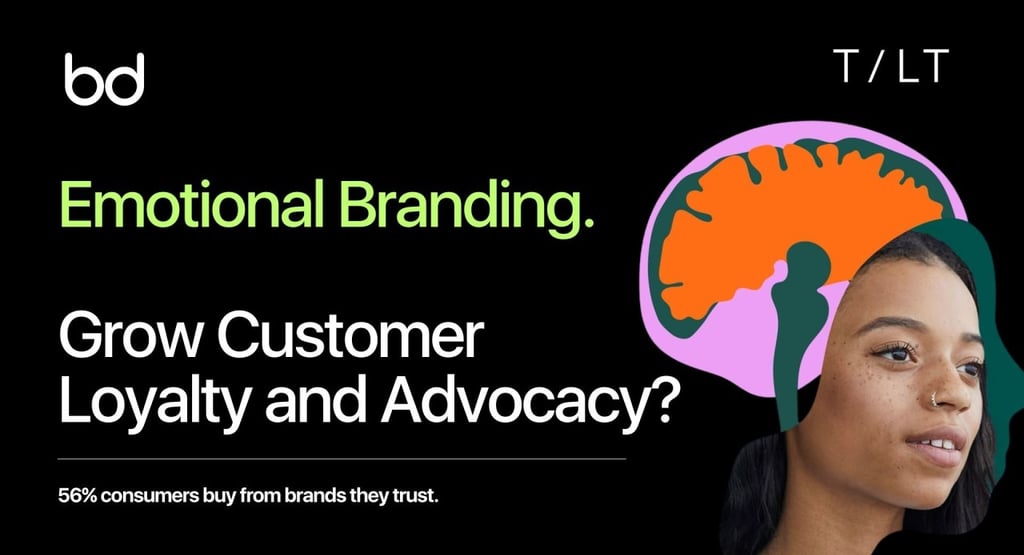Emotional Branding: The Secret to Customer Loyalty and Advocacy
True brand success is forged not in the transaction but in the heart. Emotional branding stands as the key to turning fleeting attention into lasting loyalty, and loyal customers into devoted advocates. The science is clear: brands that connect emotionally don’t just sell, they build unbreakable, enduring relationships.
Brand Blinks Global
4 min read


True brand success is forged not in the transaction but in the heart. Emotional branding stands as the key to turning fleeting attention into lasting loyalty, and loyal customers into devoted advocates.
The science is clear: brands that connect emotionally don’t just sell, they build unbreakable, enduring relationships.
Why Emotional Branding Matters: Theoretical Foundations
Emotional branding pivots on psychological principles and neuroscience, tapping into the deepest drivers of human behavior. Functional benefits (quality, price) may spark initial interest, but enduring loyalty is built on feelings of love, trust, belonging, nostalgia, and aspiration. Brands become part of a consumer’s identity, embedding themselves in the stories people tell about themselves and their world.
Maslow’s Hierarchy of Needs: Loyalty flourishes when brands help fulfill higher-level needs esteem, belonging, and self-actualization, not just utility.
Self-Congruity Theory: Customers stick with brands that “fit” their self-image and personal values, deepening emotional attachment.
Brand Attachment & Love: The emotional bond, formed when a brand consistently resonates with personal aspirations, drives repeat purchases, advocacy, and even forgiveness for occasional missteps.
The Neuroscience of Loyalty: How Brands Wire the Brain
Consumer neuroscience reveals that true loyalty isn’t just preference, it’s a result of emotional triggers activating key areas of the brain, like the amygdala and the limbic system. When customers feel cared for, understood, or inspired, their brains release oxytocin (the “bonding hormone”) and dopamine (associated with pleasure and satisfaction). gerritmcgowan
These emotional responses create stronger, longer-lasting memories, ensuring every positive brand experience reinforces future preference and recommendation.
Mechanisms that Foster Loyalty and Advocacy
Storytelling: Powerful stories connect, inspire, and transport. Research shows that emotionally engaging marketing campaigns produce higher recall and brand satisfaction than factual messaging alone. Brands that tell stories aligned with their audience’s journey build deeper trust and connection. ijrpr
Values & Purpose Alignment: Consumers champion brands that reflect their ideals, whether social causes, sustainability, or innovation. When customers feel a brand shares their values, loyalty and advocacy accelerate.
Consistent Emotional Experience: Every touchpoint matters. From website UX to product packaging and customer service, consistency creates familiarity and comfort, forming the bedrock of emotional memory. kuey
Community & Belonging: Fostering online and offline communities through forums, events, and social experiences amplifies advocacy. Customers don’t just buy; they join, contribute, and share.
Emotional Loyalty in Action: Real-World Examples
Apple: Inspires with innovation and creativity, weaving “Think Different” into user identity and aspiration.
Nike: Anchors branding in determination, achievement, and belonging to a movement (“Just Do It”).
Coca-Cola: Triggers joy and nostalgia through universal moments, sharing happiness, family, and togetherness.
Customers loyal to these brands actively advocate for them online and offline. Advocacy is propelled by shared emotional experiences, not mere satisfaction. linkedin
Actionable Strategies: Making Emotional Branding Work for You
Step 1: Identify Your Core Emotional Motivators. Use psychographic analysis to discover what your audience longs for: belonging, inspiration, and empowerment.
Step 2: Map the Customer Journey for Emotion Audit, every touchpoint from ads to support for emotional impact. Where can you add empathy, delight, or meaning?
Step 3: Craft and Share Compelling Stories. Real stories, customer wins, founder struggles, purpose-driven growth, build connection and trust.
Step 4: Build Communities. Create spaces for shared values and interests forums, loyalty programs, and co-creation platforms.
Step 5: Measure and Refine Leverage neuroscience tools and behavioral data to track emotional response and adjust strategies for deeper engagement. gerritmcgowan
The Power of Advocacy: From Customer to Brand Ambassador
Emotional branding isn’t just about retention it creates brand ambassadors. When people truly love a brand, they share, recommend, and defend it. Word-of-mouth fueled by emotion is more credible and enduring than any ad campaign. linkedin
Takeaway: Loyalty Is Emotional, Advocacy Is Human
Brands that foster genuine emotional connections go beyond transactions; they inspire loyalty, turn customers into fans, and create the most powerful force in marketing: advocacy. When your brand becomes a meaningful part of someone’s story, you’re not just building a customer base; you’re cultivating a movement.
Ready to make emotional branding work for your business? Connect with BBG’s expert team to design strategies that feel right and last long.







© 2025 BRNDXMORPH Media Worldwide Private Limited. All rights reserved
Brand Blinks Global® | BBG is an independent global brand consulting and transformation company.
The trademarks, logos, and service marks displayed on this site are the property of their respective owners.
"Brand Blinks Global®," "Brand Blinks®," "Made for the Uncommon®," and the "bd®" logo are trademarks or registered trademarks of BRNDXMORPH Media Worldwide Private Limited.
RESOURCES
INTELLIGENCE
BUSINESS
PARTNER
COVERAGE
EXPLORE
Made for the Uncommon®


When your brand grows, others rise too. 2% of your project empowers a nonprofit we back together every year.


